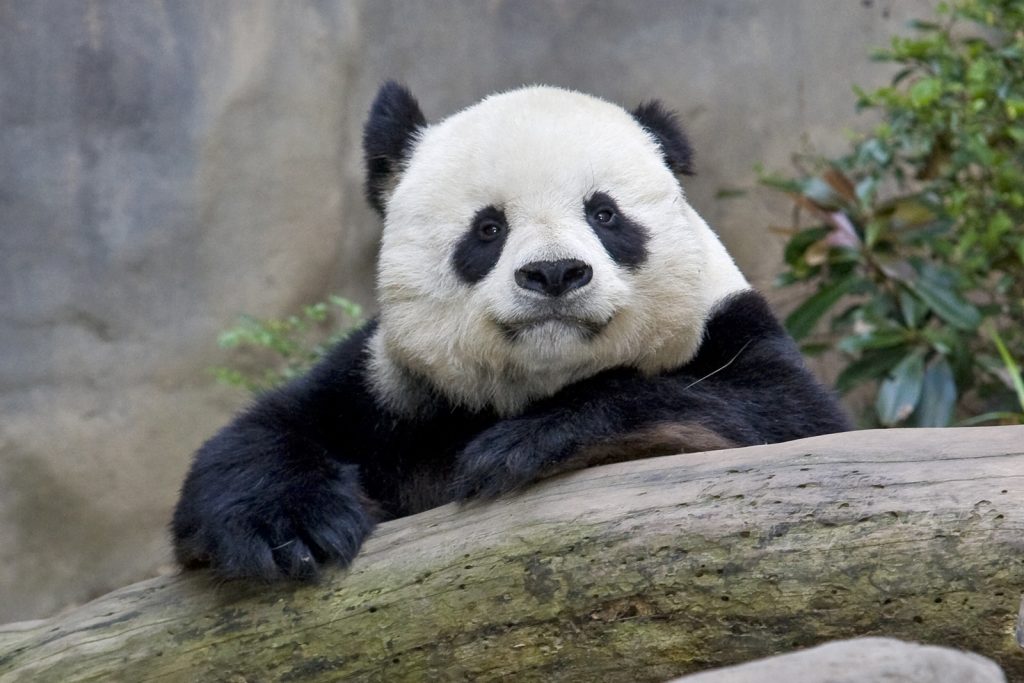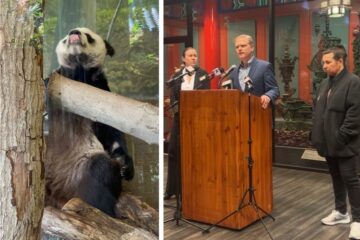Source: sandiegouniontribune
Gao Gao’s gone.
The eldest of three giant pandas at the San Diego Zoo, Gao Gao left Tuesday morning (Oct 30th, 2018) to return to China, where he was born.
The departure concludes a long-term loan from China to the zoo. By all accounts, it was a highly successful one. Along with matriarch Bai Yun, the panda pair produced five cubs, the youngest of which, Xiao Liwu, remains behind with his mother.
Gao Gao’s departure was kept under wraps for safety reasons, the zoo said. It was so secretive that the zoo wouldn’t disclose what time he left, or mode of transportation or route.
The tight security matched Gao Gao’s status. Pandas are a Chinese cultural icon as well as a rare species. Then there’s Gao Gao’s condition. He’s about 28, making him a senior panda citizen. He has had health problems in recent years. So the zoo wanted nothing out of the ordinary to occur that would upset or stress him, such as a gawking public or protests from animal-rights activists.
Transporting such a prized diplomatic cargo thousands of miles requires intense logistical planning, including training Gao Gao to accept confinement in a crate and to ignore the loud sounds around him.
Gao Gao is traveling with an experienced keeper and a veterinarian who have looked after him for years. They are senior keeper Kathy Hawk, and veterinarian Meg Sutherland-Smith.
‘We prepare (pandas) intensely for a trip,” Hawk said last week during preparations for the trip.
“Crate training, getting used to any noises like forklifts or confined spaces and everything. So we start well in advance prior to the trip.”
Add to that preparation the rapport the keepers develop with their charges.
“I’ve seen this bear just stay focused on you, if you’re hand feeding him or giving him a favorite treat,” Hawk said. “A forklift can go by. He may glance at it, but he stays absolutely focused.”
Cultural heritage
Both the zoo and the Chinese government have been carefully planning for this day for some time, said Carmi G. Penny, the zoo’s director of Collections Husbandry Science.
Since China only loans pandas, it’s expected from the day of their arrival that they will one day return. This includes pandas born elsewhere under a loan agreement — all are property of China.
Once in China, Gao Gao will first go through quarantine, then be admitted to the China Conservation and Research Center for the Giant Panda, Penny said. It’s in Dujiangyan, located in central China.
Pandas there are housed in individual enclosed areas, with access to large outside spaces, Penny said.
The details of Gao Gao’s life there will be up to his Chinese keepers.
Pandas have immense cultural significance for the Chinese, said Edward Dong, a Chinese-American businessman with extensive professional ties to China. He is founding chair of the US-China Committee, part of the International Leadership Foundation, a non-profit focused on developing civic and cultural leaders in the Asia-Pacific region.
Pandas are regarded in a sense as Chinese citizens, said Dong, who was born in China and lives in San Diego.
Bringing Gao Gao home to live out his last years on Chinese soil is extremely meaningful to the Chinese people, said Dong, who earned a master’s degree in public administration in 2015 from Harvard University’s Kennedy School of Government.
That said, neither the Chinese government nor the zoo would risk repatriation if Gao Gao weren’t in a condition to withstand travel, Dong said.
It’s also true that the Chinese government uses its strategic loans of pandas as part of its “soft diplomacy,” Dong said. Panda loans are a visible sign of good relations between China and their host countries.
Contributions
Besides five offspring, Gao Gao also gave panda researchers at the zoo and elsewhere a wealth of information about what makes a successful panda papa. And panda populations in the wild and captivity have mushroomed.

Because of his age, Gao Gao’s breeding years are behind him. In 2014, his cancerous right testicle was removed. It was a non-aggressive type of tumor, called a seminoma, which generally does not metastasize. He also takes medication for a heart condition.
So Gao Gao has been off exhibit for the last few years.
In retirement, Gao Gao had his own private patio, with tree stumps to climb if he was in the mood, food, and even hay to lie down in.
Gao Gao also had an indoor area to which he was brought during the night, a sort of den where he would be more easily watched over.
Last Saturday morning, Gao Gao got up for an early meal, then lazily lay down sideways. His eyes closed, his pink tongue flickering in and out. He got up, turned around, then once again lay back down.
It’s unknown whether another panda or pandas will be sent to replace Gao Gao. There has to be a legitimate research purpose, Penny said.
If so, the zoo is prepared: its panda center can accommodate up to six pandas, Penny said.
Successful history
China has sent pandas to other countries for centuries. They were originally sent as gifts, but in recent decades China has made only panda loans, retaining ownership and requiring their eventual return.
So called “panda diplomacy” brought a gift of the pandas Hsing-Hsing, a male, and female Ling-Ling to the United States in 1972. They were sent to the National Zoo in Washington, D.C., where they lived for many years.
The gift came in response to President Richard Nixon’s historic trip to China earlier that year. That initiative helped thaw relations between the two governments, which had previously been on unfriendly terms for decades.
However, while Ling-Ling bore cubs, none of them survived more than a few days. No panda cub born in the United States survived to adulthood until 1999, when Hua Mei was born at the San Diego Zoo to Bai Yun.
The San Diego Zoo’s first panda loan took place in 1987, when Basi and Yuan Yuan were hosted for 200 days to much excitement.
For the next decade, the zoo pursued a more long-term arrangement. That had to be approved by both the Chinese and U.S. governments. The zoo submitted a proposal to study panda procreation, so they asked for a male and female.
Bai Yun arrived with Shi Shi in 1996. But he wasn’t at all interested in Bai Yun’s amorous advances. Their only child was born by artificially inseminating Bai Yun.
Gao Gao arrived at the zoo in January 2003, as a replacement for Bai Yun’s first intended partner, Shi Shi.
Gao Gao proved more proficient at procreation, fathering five cubs with Bai Yun, all the natural way.
With advancing age and the ailments of age, Gao Gao went off public viewing. He was moved to the Giant Panda Research Building, not far away from Bai Yun and Xiao Liwu, their last cub.
Dong, the Chinese-American businessman, said the zoo has a decent chance of getting another panda. The existing agreement covering Bai Yun and Xiao Liwu was recently extended until next year, while the next phase of the partnership is being worked out.
While politics and diplomacy have their influence on panda loans, Dong said the zoo’s long-term contributions to understanding, propagating and protecting pandas weighs heavily in its favor.
“These relationships have underscored how valuable are the contribution San Diego has made to the conservation efforts for the pandas,” Dong said.


